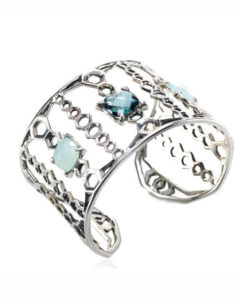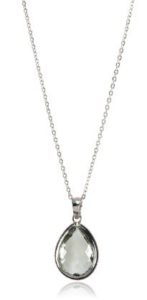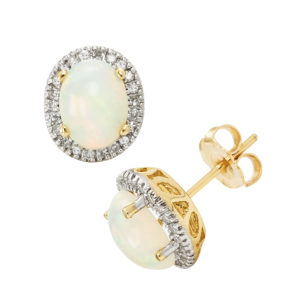Working the Trends
Identifying a trend is a continuous effort of compiling observations, shares London fashion forecaster, blogger and designer Geraldine Wharry for Trend Atelier, who dubs it a “hunting and gathering” process. It requires a lot of curiosity and interest in a wide array of subjects, she cites, including art and design, science and technology, socio-economics, and food and travel.
 Wharry describes trends forecasting to be much like archeology, but to the future. “Every trend has its roots somewhere in history,” she explains, noting that design is cyclical, with evolutions usually interpreted in new ways. “While you’re looking forward, you’re also taking into account the past. You realize it’s one big creative loop that is constantly growing and updating itself.”
Wharry describes trends forecasting to be much like archeology, but to the future. “Every trend has its roots somewhere in history,” she explains, noting that design is cyclical, with evolutions usually interpreted in new ways. “While you’re looking forward, you’re also taking into account the past. You realize it’s one big creative loop that is constantly growing and updating itself.”
Fashion Connection
Jewelry stylist-to-the-stars Michael O’Connor advocates jewelers look at fashion and lifestyle publications, websites and blogs to follow and engage in the conversation. While runway trends influence people’s choices, with looks translated on the streets right away, he believes what happens on the red carpet gives consumers their first and best glimpse of how the latest fashions and accessories, even hair and make-up are put together to complete a look.
“Women don’t want to copy their favorite celebrities, they use them as a guidepost for what’s hot,” tells O’Connor. “You can use these visuals as a way to merchandise in displays, start conversations, and post on social media, blogs, and enews. Identify how your jewelry speaks to what’s trending. Think less about the product, and more about how it is used to create a look or a feeling.”
The underlining reason women go shopping is to be inspired. “Consumers want to know how to put things together,” O’Connor says. “They want ideas on how they can look their best and create their own signature style.” He sees lots of latitude to explore top trends and make them your own: layering (necklaces of different lengths and styles), stacking (bands, bangles and cuffs), and color (gem drop earrings and cocktail rings) to inspire the “never-thought-of-that” reaction.
Make the trends accessible to your customers. A great example is in Richline’s latest collection that speaks to layering and color. “Our research shows that young women are looking for gemstones that are unique and will make them stand out,” tells Maureen McIntyre, vice president of merchandise for gemstones and pearls, Richline. “We introduced a line using fresh silhouettes with green tourmaline, pink tourmaline, tanzanite and apatite. The styles are petite, perfect for layering. Using these expensive stones in smaller sizes and fancy cuts like baguettes make them affordable and easy for self purchase.”
Eddie Weiss, EMA Jewelry, New York concurs that a focus on fashion is what women want, with demand strong for color gemstones set in gold, in designs that have good value and are affordable. He cites chokers, bolo bracelets, and stackable rings among the bestsellers.
 Versatility and wearability are key purchase drivers, says designer Sara Blaine, a Benchmark partner in Atlanta, who rates the lariat popular with her customers. “They love it because you can do a lot with it—wear it as a choker, layer it with other necklaces, make it a belt, wrap it around your wrist.” She deems it critical for jewelers to have sales associates wear jewelry from stock, as well as style looks in display cases and for digital and print media.
Versatility and wearability are key purchase drivers, says designer Sara Blaine, a Benchmark partner in Atlanta, who rates the lariat popular with her customers. “They love it because you can do a lot with it—wear it as a choker, layer it with other necklaces, make it a belt, wrap it around your wrist.” She deems it critical for jewelers to have sales associates wear jewelry from stock, as well as style looks in display cases and for digital and print media.
“You don’t need big trendy pieces, you just need the right sales people who are interested in fashion and style to show and tell. People are looking for ideas.” Blaine suggests bringing in a stylist for the day, or have sales associates become personal shoppers for their clients. “Encourage customers to explore, mix and match, and see what can work with what they have.”
Digital Tracking
Wharry hails Pinterest an effective online resource to track inspirations, ideas, and advice. “Pinterest is especially helpful because it tracks the source of the information so you can come back to it again.”
Tracy Chapman, women’s marketing expert and director of strategic planning for the New York-based Terri & Sandy Solution hails Pinterest and Instagram key visual tools jewelers can use to help customers connect the dots, as well as create more targeted communities ideal for customer outreach and data collecting. “You need to understand your audience to know how to make the trends relevant. One ring doesn’t fit all, just like one trend doesn’t fit everyone.”
Stephanie Holland, author and founder of She-conomy, marketing to women, Birmingham, Alabama says it’s easy to find out what customers want, just ask them. “Social media is an excellent means of gaining this knowledge. Every company has access to develop customer data, and social media is a tool you can benefit from right away. The key is to hear what customers say and act on it. It requires you self evaluate and get to know your customers.”
Amanda Gizzi, director of public relations and special events for Jewelers of America advises jewelers be where their customers are on social media. Fun and personal, she says color stones generally receive high engagement on social media, a low-cost way to reach consumers with targeted messages. Wharry notes that while people are following the trends, they’re curating their own point-of-view. Guided by what designers, celebrities and bloggers are touting, she advocates being an influencer of your take on the trends.







